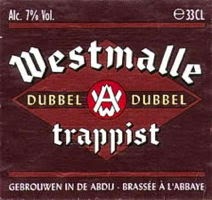 Two of my neighborhood pubs have had Belgian beer events recently, so lately I've had Belgium beer on the brain, both figuratively and literally.
Two of my neighborhood pubs have had Belgian beer events recently, so lately I've had Belgium beer on the brain, both figuratively and literally.Belgium has a variety of unique beer styles, but the beers most often associated with Belgium are the Trappist Abbey ales.
 Trappist Ales are not actually a single style of beer, but rather a designation of who made the beer. Trappist Ales are made in a monastery by monks, and there are only a handful of Trappist breweries around. You can recognize these beers by the Trappist logo on the label.
Trappist Ales are not actually a single style of beer, but rather a designation of who made the beer. Trappist Ales are made in a monastery by monks, and there are only a handful of Trappist breweries around. You can recognize these beers by the Trappist logo on the label.Trappist breweries also follow the tradition of using different colored bottle caps to tell their beers apart. This tradition predates the labeling of bottles.
The designation "Trappist" on a beer label guarantees that the beer was produced at a Trappist monastery, that monks manage the brewery and oversee production, and that brewery profits benefit the social services for the community.
The extreme popularity of Trappist ales has led to many secular breweries creating beers in similar styles. These beers are often called Abbey ales to distinguish them from similar beers made by Trappists.
Trappist and Abbey ales come in several styles, each named for their relative strength.
Singels are pale, low alcohol brews made for the monks to keep for themselves. You probably won't see on outside of a monastery.
Dubbels are reddish-brown ales with a large off-white head of foam. The use of caramalized sugar in brewing gives the beer a deep color, lightens the body of the beer, and creates an alcohol level of about 6 to 8%. Dubels will have plum-like aromas with flavors of raisins, dates, caramel, sometimes black cherry, and maybe chocolate. Despite the fruit flavors, these medium-bodied beers finish dry. There is little, if any, hop bitterness.
While monasteries have made brown ales since the Middle Ages, the Dubbel was popularized in 1926 by the Westmalle monastery.
|
|
|
The Triple was popularized in 1956, and like the Dubel, the style was developed by the Westmalle monastery.
Tripels are also brewed with added sugar, but with Tripels the sugar is not caramelized. You will get elevated alcohol, 7 - 10% ABV, but the beer will be orange-gold with a thick, plush head of white foam.
There are fruity aromas of apples, oranges, lemons, and maybe bananas, along with an element of pepper and a slight touch more hop bitterness than a Dubbel.
These beers are dangerously easy to drink.
|
|
Belgian beers excel at pairing with food.
Dubbels go great with rich, flavorful meats like lamb or duck, or sausages that go heavy on the herbs.
The richness of Dubbels also pairs well with beef stew, particularly if you throw in some apples or prunes. Remember to add some beer to the sauce to seal the deal. Braised short ribs would work too. If you like a more boldly flavored sauce, then pair that with the Quad.
Tripels go well with herb-heavy dishes like sausage or cassoulet, and tripels can also pair well with pesto dishes. The citrus notes of the beer can pair with dishes using a subtle lemon or orange sauce, and the citrus notes also work with stronger flavored grilled fish. I like Chimay Cinq Cents with grilled salmon. The citrus notes complement the fish while the slight hop bitterness mirrors the char from the grill.
What about the cheese?
Dubels have a caramel flavor that pairs well with cheeses that have aged long enough to develop caramel flavors of their own. Try a Dubbel with an aged Gouda. Look for a Gouda about 18 months old - too much older than that and the cheese will overpower the beer.
I like to pair Tripels with a softer, slightly pungent, washed-rind cheese like Morbier. The monks at Chimay also make cheeses that they wash with their beer, so give that combination a try.
Serving Suggestions
Don't serve these beers too cold, 55 to 60 degrees F works best, and pour them into a snifter or large wine glass to concentrate the unique aromas.
Abbey ales will often include yeast in the bottle, and there's a little trick to pouring one of these bottle-conditioned beers:
Please don't take my food and cheese suggestions as dogma. These beer parings aren't carved in stone.
Belgian beer can pair well with anything. Really. It's a food pairing superstar. Abbey ales will enhance the flavor of most food and pairing them with food brings out the complexity of the beer.
Abbey ales are a gift from heaven!









No comments:
Post a Comment